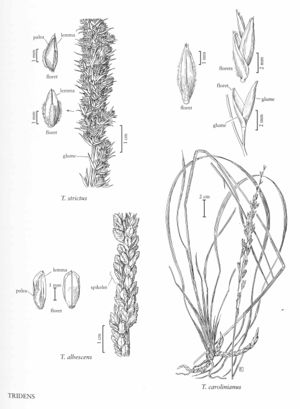Difference between revisions of "Tridens strictus"
FNA>Volume Importer |
FNA>Volume Importer |
||
| Line 17: | Line 17: | ||
-->{{Treatment/Body | -->{{Treatment/Body | ||
|distribution=Pa.;Kans.;Okla.;Miss.;Tex.;La.;Mo.;Ala.;Tenn.;N.C.;S.C.;Va.;Ark.;Ill.;Ga.;Ky.;Fla. | |distribution=Pa.;Kans.;Okla.;Miss.;Tex.;La.;Mo.;Ala.;Tenn.;N.C.;S.C.;Va.;Ark.;Ill.;Ga.;Ky.;Fla. | ||
| − | |discussion=<p>Tridens strictus grows in open woods, old fields, right of ways, and coastal grasslands. It is endemic to the United States.</p> | + | |discussion=<p><i>Tridens strictus</i> grows in open woods, old fields, right of ways, and coastal grasslands. It is endemic to the United States.</p> |
|tables= | |tables= | ||
|references= | |references= | ||
| Line 26: | Line 26: | ||
-->{{#Taxon: | -->{{#Taxon: | ||
name=Tridens strictus | name=Tridens strictus | ||
| − | |||
|authority=(Nutt.) Nash | |authority=(Nutt.) Nash | ||
|rank=species | |rank=species | ||
| Line 33: | Line 32: | ||
|basionyms= | |basionyms= | ||
|family=Poaceae | |family=Poaceae | ||
| − | |illustrator=Linda A. Vorobik | + | |illustrator=Linda A. Vorobik;Karen Klitz |
| + | |illustration copyright=Utah State University | ||
|distribution=Pa.;Kans.;Okla.;Miss.;Tex.;La.;Mo.;Ala.;Tenn.;N.C.;S.C.;Va.;Ark.;Ill.;Ga.;Ky.;Fla. | |distribution=Pa.;Kans.;Okla.;Miss.;Tex.;La.;Mo.;Ala.;Tenn.;N.C.;S.C.;Va.;Ark.;Ill.;Ga.;Ky.;Fla. | ||
|reference=None | |reference=None | ||
| Line 39: | Line 39: | ||
|publication year= | |publication year= | ||
|special status= | |special status= | ||
| − | |source xml=https:// | + | |source xml=https://jpend@bitbucket.org/aafc-mbb/fna-data-curation.git/src/f50eec43f223ca0e34566be0b046453a0960e173/coarse_grained_fna_xml/V25/V25_49.xml |
|subfamily=Poaceae subfam. Chloridoideae | |subfamily=Poaceae subfam. Chloridoideae | ||
|tribe=Poaceae tribe Cynodonteae | |tribe=Poaceae tribe Cynodonteae | ||
Revision as of 21:36, 16 December 2019
Plants with hard, knotty, shortly rhizomatous bases. Culms 50-170 cm, stiffly erect. Sheaths rounded, glabrous except for a few hairs on either side of the collar; ligules about 0.5 mm, membranous, ciliate; blades 2-8 mm wide, flat or loosely infolded, glabrous, tapering to the apices. Panicles 10-30(36) cm long, 1-2 cm wide; branches to 6 cm, erect or appressed; pedicels 1-1.5 mm, glabrous. Spikelets 4-7 mm, with 5-11 florets. Glumes 4-7 mm, always conspicuously exceed¬ing and often twice as long as the adjacent lemmas, usually equaling or exceeding the distal florets, glabrous, 1-veined, tapering to acuminate apices; calluses pilose; lemmas (2)3-3.5 mm, veins pilose to well above midlength, lateral veins often excurrent; paleas 2-3 mm, bases not bowed-out; anthers 1-1.5 mm. Caryopses 1-1.5 mm. 2n = 40.
Distribution
Pa., Kans., Okla., Miss., Tex., La., Mo., Ala., Tenn., N.C., S.C., Va., Ark., Ill., Ga., Ky., Fla.
Discussion
Tridens strictus grows in open woods, old fields, right of ways, and coastal grasslands. It is endemic to the United States.
Selected References
None.
